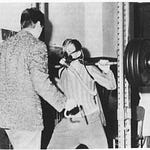In Story 2 of my personal experiences with ideological drama in academic peer review, we learned of a peer reviewer at the journal Sports Medicine who rejected one of my papers because I presented data to support my position that volunteer self-selection bias might be a contributing factor to fewer female than male participants in certain exercise research trials. The reviewer stated “Data be damned, I know women are understudied and you will not convince me otherwise. Perceptions trump data.”
What we learned from Story 2 was that some peer reviewers are cognitively unfit for the job, and they are particularly sensitive to papers that challenge ongoing narratives about women’s issues.
With this background of unhinged feminist reviewers in mind, you might perhaps understand the hesitancy of the editor at Sports Medicine to consider a second Nuzzo submission that challenges another feminist talking point: “gender-based violence.”
This is the topic of Story 3.
In September of 2022, I led an effort , along with Deborah Powney of the University of Central Lancashire and Dr. John Barry of the Centre for Male Psychology, to challenge a commentary published in Sports Medicine that presented a one-sided story about “gender-based violence.” The authors of the commentary claimed that the entire field of exercise science has “blind spot” for this violence, by which they meant only violence against girls and women. They also stated that students of exercise science should be educated about this topic in their coursework.
We submitted a letter to the journal’s editor, summarizing evidence showing roughly equal rates of male and female victimization in terms of being victims of both intimate partner violence and violence within sports environments. We also called out the authors for not providing any evidence that exercise scientists actually have a “limited awareness” of violence data. Because of their lack of discussion on male victimization, we concluded that the actual “blind spot” resided with the authors themselves, not the entire field of exercise science.

After receiving our letter, the editor sent it out for peer review. The editor’s decision to send our letter out for review was unusual because letters to the editor are specifically addressed to the editor, and historical precedence is that letters are not sent out for peer review.
One reason letters are not typically sent out for review is that doing so contradicts one of the purposes of a letter, which is to stop or slow the propagation of inaccurate data or a misguided ideas presented in a paper. Letters often challenge results and conclusions presented in papers. Thus, to the extent that a letter expresses important concerns about a paper, the letter should be published as quickly as possible so that clinicians, researchers, policymakers, and the general public are made aware of such potential issues. Placing a letter under full review, rather than simple editorial review, hinders the full effectiveness of a letter. Moreover, letters are often short opinion pieces. Therefore, because of this purpose of letters, plus the fact that they are are typically held to a lower publication standard than full-length articles, the rate of acceptanceof letters is much higher than full-length articles.
Yet, the editor sent our letter out to three peer reviewers. When I asked the editor why he did this, his response was that the journal was now following a policy in which letters that might be deemed “controversial” would be sent out for review.
Encouragingly, about two months later, on December 6th, we were sent the comments from the three reviewers, and their feedback was largely supportive. They believed our letter should be published, and their feedback helped to improve the letter.
We submitted the revised version of our letter about one week later, on December 15th. Surprisingly, the editor sent our letter back out for review. He sent it to the same three initial reviewers. For full-length articles to be sent out for a second round of reviews or final approval is not uncommon. However, for a letter to go through a second round of reviews is unheard of. Again, this slows down a piece that should be published as quickly as possible.
We then had to wait for the three reviewers to give their final nods of approval. These nods came on January 23, 2023. But the story does not end there.
With letters, the authors of the original paper get a chance to reply to the letter that critiques their work. This is a fair and healthy academic practice. However, some journals, like Sports Medicine, abide by policies in which they publish the letter and the authors’ reply to the letter simultaneously. From a pure publishing and reader engagement standpoint, this makes sense. However, this causes further delays in getting the letter out to the public, because the opposing authors need to be given time to draft their own letter.
According to the editor, the authors’ reply was due by February 6th. As of March 11th, I had not been updated by the editor, so I asked him for a status update. He informed me that the authors’ reply was out with peer reviewers and that I could expect an update in 2-3 weeks.
“What?!” I asked myself, figuratively banging my head against the desk. “Why would the editor send the authors’ reply out for peer review? The authors are simply responding to the critiques that we presented in our letter. Of what business is it of peer reviewers to weigh in on the authors’ responses to our critiques?”
More than three weeks then went by without a word from the editor. So, on April 7th, I emailed the editor expressing my concerns with the delays. Also, as I have published full-length articles on the purpose of letters, I also shared with the editor some of my opinions on how, philosophically, I thought the way that this letter exchange was being handled was inappropriate. Namely, I pointed out, in a civilized manner, the absurdity in having the authors’ reply sent out for peer review. The editor responded professionally, saying that the delays were due to the time needed for the authors and reviewers to complete their respective tasks.
So, again, I waited.

A month went by, and I had not heard from editor. On May 12th, I emailed him once again, asking for a status update. The editor responded within a few hours, with some surprising news. The editor stated that as of a couple of days ago, he had learned that the authors elected to withdraw their reply from consideration for publication. The reason for the withdraw was not revealed to me.
Our letter was finally published online on June 13, 2023. The unfortunate thing about this process was that our letter, which was first submitted on September 29, 2022, was deemed suitable for publication back in January of 2023, which means that our letter could have been online about six months earlier than its final publication date, if not for the unnecessary safetyism associated with our critique of the authors’ narrative on “gender-based violence.”
It is hard to know what, if any, damage this unnecessary safetyism has had on the exercise science field. For example, during the six month period in which our accepted letter was hanging about unpublished, dozens or hundreds of exercise science lecturers could have read the commentary, shared it with colleagues, and then started to create educational content based on the information in the article. To the extent this occurred, this is the cost of excessive safetyism.
Nevertheless, our letter did eventually get published. And that represents a small win for reason. For a discussion about the letter and the experience with the journal, please see my recent interview with Bettina Arndt on Substack. A personalized reading of our letter has also been published here at The Nuzzo Letter.
Related Content at The Nuzzo Letter
SUPPORT THE NUZZO LETTER
If you appreciated this content, please consider supporting The Nuzzo Letter with a one-time or recurring donation. Your support is greatly appreciated. It helps me to continue to work on independent research projects and fight for more evidence-based discourse. To donate, click the DonorBox logo. In two simple steps, you can donate using ApplePay, PayPal, or another service. Thank you.




















Share this post